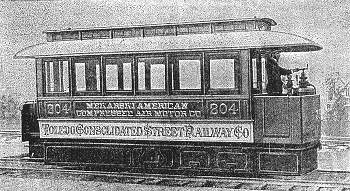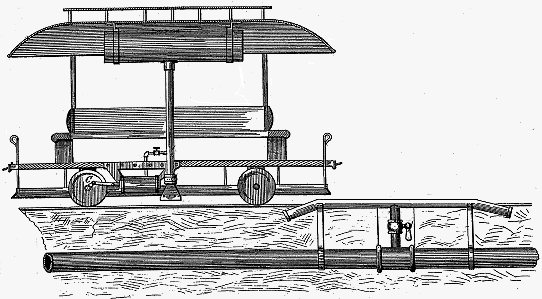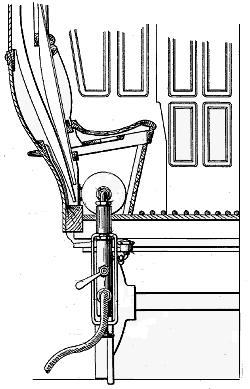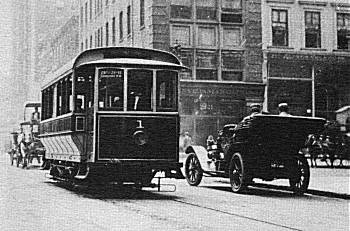 |
Compressed Air Trams
By John Prentice |
 |
Compressed Air Trams
By John Prentice |
The European high pressure systems were never used commercially in the U.S., but some trams, mostly using low pressure, were tried in a number of places. However, they met with the same fate as the low pressure tests in the U.K. at Chester. Note also that the Popp-Conti low pressure system, described in the Paris section, was equally a failure. Some early U.S. patents even suggest the use of compressed air to assist the starting of horse drawn trams, but this was probably never tried.
 A Mékarski car running on trial in Toledo, Ohio.
A Mékarski car running on trial in Toledo, Ohio.
The "Mékarski American Compressed Air Motor Company" was set up in the 1880s to try to establish the French system in the U.S., and a car to the Louis Mékarski design was experimentally tried, probably on a number of tramways including the Toledo Consolidated Street Railway Company.
The Mékarski test car is said to have had six air reservoirs made of half inch steel plates, with a total volume of 536.25 U.S. gals plus three reserve reservoirs containing a further 281.5 U.S. gals. The heated "Bouillotte" had a capacity of 53 gallons of air and water, at a temperature of 311 degs. F. The air was fed to a pair of cylinders, each being a tandem double expansion unit in a single casting with shared slide valves. It was claimed that on the level the car would run for 12.5 miles without charging, reduced to 9 miles on gradients, and would take about 15 minutes to recharge. It was estimated that the cost (including wages and repairs) of running a 60 mile day was six and a half dollars, or 10-11 cents per car mile.
In 1878 the Second Avenue Railroad of New York City tested and then operated for a period in 1879, five cars built by the Pneumatic Tramway Engine Company incorporating designs by Robert Hardie, who it is thought had previously worked in Glasgow, Scotland with W. Scott-Moncrieff and who had General Herman Haupt, a civil engineer, as an enthusiastic backer. The engine was single expansion with hot water preheating and regenerative braking, where using the engine as a compressor to slow the tram, hot air could be forced back into the storage tanks, so increasing the range.
In 1885 in Cincinnati a car was built with a storage reservoir tank built into its floor, using a double layer similar to a ship's hull, and charged to 80 p.s.i. (pounds per square inch - about 5 atmospheres). To replenish the tank an iron pipe was continuously laid 15 in. below the road surface between the tracks, beside the track if it was single. It was tested to 125 p.s.i. but charged to about 100 p.s.i. by a twelve horsepower engine. There were pick up points at each stop, which were automatically engaged. The charge it was claimed took just six seconds and the car would be 'equivalent to six horses'. In practice the car would stall and had to wait to charge up and thus the trial was not a success.
George A. Clarke, the promoter of the Cincinnati line, stated in the Cincinnati Gazette that for only 7,000 dollars per mile any tramway could he converted to his air system, without any break of service, and after which all operating costs would be much reduced. There was no rush to take up his proposals.

A number of American inventors thought that the solution to poor efficiency with low pressure trams or as a safer alternative to high pressure trams, was to provide the cars with a continuous or at least very frequent supply of air. Patents were filed by Leonidas Pressley of the Automatic Connection Compressed Air Car Motor Company of San Francisco in 1887, a modification of that by John T. Clark in 1888, and by William Farrar in 1897 (also by John Hughes of Chester, U.K. in 1888). These all specified methods whereby a pipe containing the compressed air would be laid between the rails for the whole length of the line, and then the car would be connected to that pipe by automatic devices that would provide the car with a charge at regular intervals while still in motion. None of these was ever tried.
Around 1895 cars built by the General Compressed Air Company of New York to Robert Hardie's designs were tried in Rome, New York State. These small single deck trams ran for about 21 months and it was claimed took 2 minutes to charge giving about 45 minutes of slow running. Again lack of efficiency caused their withdrawal, and these claims were probably generous.

In 1895 and 1896 Hardie filed patents for an improved version of cars using high pressure air and giving "better control and increased efficiency". This design included a hot-water air-reheater and advanced speed control and braking regulators and was very similar to the French Mékarski machines. The driving cylinders were mounted on the truck frames with a linkage to the outside connecting rods. This avoided the use of a cranked axle, thus leaving more space for the air reservoirs. Stephenson's valve link-gear was connected to the rear axle. It is most likely that this patented high pressure system was used in Rome, NY. Hardie's high pressure system was certainly tried on locomotives of the Manhattan Elevated Railway and his patent states that "Motor-cars constructed in accordance with this specification are in extensive use and known as the 'Hardie air-motor or street-car system' ".
Other American systems are said to have tested compressed air cars. There was one trial in Chicago in 1899 on the North Clark Street line using a Hardie car, occasionally pulling two trailers, and charged with air at Elm Street. Between 1894 and 1899, several were tested on different lines in New York (including 23rd, 24th, 28th, 29th and 125th streets), some probably with Hardie cars, but without lasting success. During this period the Hoadley-Knight cars from Joseph H. Hoadley and Walter H. Knight were tried in New York. Some of these used a two-stage expansion engine, claimed to be the first in the U.S. The initial New York trials were supplied with air at 1,000 p.s.i. by the 1,500 horse power steam driven four-stage compressor used by the Manhattan Elevated Railway.
 Joseph H. Hoadley's 1896 design for the flexible connection used to fill the reservoirs housed below the car's longitudinal seats. Included was a stop-cock and device to mix lubricating oil with each air charge.
Joseph H. Hoadley's 1896 design for the flexible connection used to fill the reservoirs housed below the car's longitudinal seats. Included was a stop-cock and device to mix lubricating oil with each air charge.
In 1899 New York's Metropolitan Street Railway Company undertook the operation of its east-west routes on Twenty-eighth and Twenty-ninth Streets with compressed air. On Manhattan Island, the east-west streets are fairly short and straight, ideally suited for air operation. The installation was contracted to the Compressed Air Power Company of New York. In May and June initial tests had been undertaken on Twenty-third Street, comparing the compressed air cars with the existing conduit electric cars on that route. The main power house was located at Twenty-fourth Street and Thirteenth Avenue, with car charging by flexible hose being done nearby at the foot of West Twenty-third Street, close to the Pennsylvania Railroad station. Charging a car with compressed air and steam for reheating took about two minutes. A car could run at 12 m.p.h. for 16 miles per charge. The power house had a 60ft high, 1,000 horsepower compressor, with four stage compression and cooling at 60 p.s.i., 300 p.s.i., 900 p.s.i. and 2,500 p.s.i.
 A compressed air car in Manhattan, probably running on trial.
A compressed air car in Manhattan, probably running on trial.
The Compressed Air Power Company had acquired the Hoadley and Knight patents and, for use on the Metropolitan Street Railway lines, had improved the design. Twenty cars were built by the J. G. Brill Company of Philadelphia. They had extra strong floor frames and longitudinal seats. They were mounted on 8ft wheelbase Brill 21E 4-wheel trucks with 33in diameter cast iron wheels. A double motor was fitted over each end of the truck, with a double crank shaft parallel to the axle and geared to it with 1:2.5 ratio spur gears. Air was stored in six reservoir cylinders, three under each car seat, being 21ft in length and 9in in diameter and with 5/16in thick walls, each weighing 300lbs and containing 7.5 cubic feet of air weighing 50lbs at 2,500 p.s.i. On leaving the cylinders the air passed through a reducing valve and a hot water tank for air reheating (located transversely under the centre of the car), to the high pressure cylinders of the motor of the forward axle at 150 p.s.i. and then to the low pressure cylinders at the other end of the car at 75 p.s.i.
One slight variant was in New Orleans where in 1886 the Standard Fireless Engine Company tested a self-contained tram on the route between Carrollton and Canal Streets, and advertised in the Street Railway Journal. Instead of compressed air the car used ammonia gas, half the weight of air, forced by pumps at 180-200 p.s.i. (at which pressure it would be turned to liquid) into a strong iron reservoir under the floor of the car, which was similar to a horse tram but higher on its wheels. Gas was fed to the cylinders via a regulator and reversing lever mounted on the tram platform. After use the gas was fed into an airtight water tank under the car, where it was readily absorbed and from where it could later be recovered. Water will dissolve 700 times its bulk of ammonia, i.e. one cubic foot of water will absorb 700 cubic feet of gas. The car was a failure due to the leaks, which in an air car are a nuisance but in an ammonia car could prove fatal.
It is a mystery why anyone should prefer to use dangerous compressed ammonia instead of compressed air, but the writer suspects that Standard Fireless were influenced by Dr. Emile Lamm, also of New Orleans, who in 1871 had designed a tram powered by liquid ammonia, heated by hot water to aid release of the gas. Lamm went on to design in 1872 a fireless steam locomotive, also tested at Carrollton. In France in 1876, Leon Francq perfected Lamm's design and from 1878 a regular service of fireless loco hauled trams started running in Paris (also used in Lille-'78, Lyon-'88 and Marseille-'93) where they succesfully continued to run on the Paris Saint-Germain tramway until 1911 (see Postcard).
We shall now return to France and the large Paris compressed air systems.
![]() Go now to Next Section
Go now to Next Section
![]() Return to Index
Return to Index